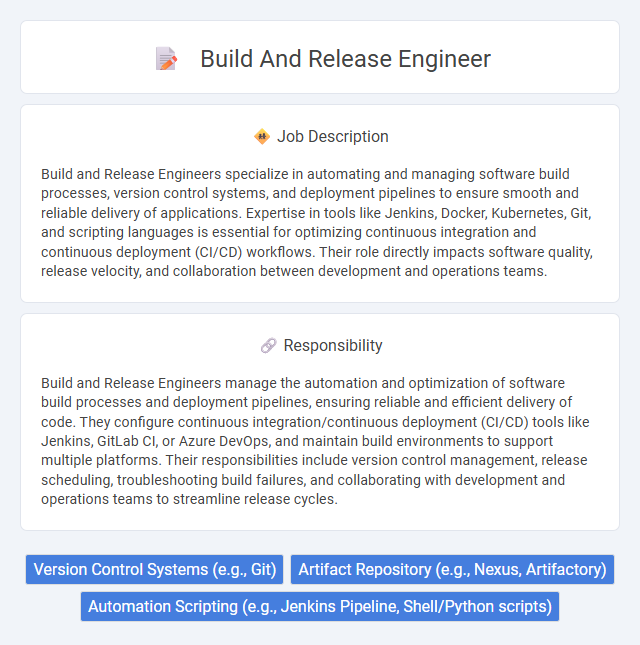
Build and Release Engineers specialize in automating and managing software build processes, version control systems, and deployment pipelines to ensure smooth and reliable delivery of applications. Expertise in tools like Jenkins, Docker, Kubernetes, Git, and scripting languages is essential for optimizing continuous integration and continuous deployment (CI/CD) workflows. Their role directly impacts software quality, release velocity, and collaboration between development and operations teams.
Individuals with strong problem-solving skills, attention to detail, and a passion for automation are likely to thrive as Build and Release Engineers. Those who prefer structured environments and enjoy collaborating with development and operations teams may find this role suitable. Candidates who struggle with high-pressure situations or resist continuous learning might face challenges in meeting the demands of this position.
Qualification
A Build and Release Engineer requires proficiency in automation tools such as Jenkins, Git, and Maven, alongside strong scripting skills in Python, Bash, or PowerShell. Expertise in continuous integration and continuous deployment (CI/CD) pipelines, version control systems, and containerization technologies like Docker and Kubernetes is essential. A deep understanding of software development lifecycle, cloud platforms (AWS, Azure, or GCP), and troubleshooting complex build issues enhances job performance significantly.
Responsibility
Build and Release Engineers manage the automation and optimization of software build processes and deployment pipelines, ensuring reliable and efficient delivery of code. They configure continuous integration/continuous deployment (CI/CD) tools like Jenkins, GitLab CI, or Azure DevOps, and maintain build environments to support multiple platforms. Their responsibilities include version control management, release scheduling, troubleshooting build failures, and collaborating with development and operations teams to streamline release cycles.
Benefit
A Build and Release Engineer likely enhances software development efficiency by automating build processes and managing releases, reducing errors and downtime. They probably improve collaboration between development and operations teams, increasing deployment speed and reliability. This role may contribute to overall product quality and faster time-to-market, offering significant value to organizations.
Challenge
Build and Release Engineers likely face significant challenges in maintaining seamless integration and continuous delivery pipelines, where the probability of encountering complex dependency conflicts or deployment failures is high. Managing diverse environments and coordinating with cross-functional teams may increase the risk of versioning errors and process bottlenecks. The role probably demands constant adaptation to new tools and automation scripts to mitigate potential disruptions in software release cycles.
Career Advancement
A Build and Release Engineer plays a crucial role in automating software deployment processes, ensuring seamless integration and delivery across development teams. Mastery of continuous integration/continuous deployment (CI/CD) tools and cloud platforms significantly enhances career advancement opportunities within DevOps and software engineering domains. Pursuing certifications in Jenkins, Docker, Kubernetes, and AWS can accelerate progression toward senior roles and leadership positions in technology infrastructure.
Key Terms
Version Control Systems (e.g., Git)
Build and Release Engineers manage Version Control Systems such as Git to streamline code integration, branching, and merging across development teams. Mastery of Git workflows, including feature branching, pull requests, and tagging, is essential for maintaining codebase integrity and enabling continuous integration and continuous deployment (CI/CD) pipelines. Their expertise ensures automated build processes, rapid release cycles, and rollback capabilities to support agile software development.
Artifact Repository (e.g., Nexus, Artifactory)
A Build and Release Engineer manages artifact repositories like Nexus and Artifactory to store, organize, and distribute build components efficiently. These tools streamline continuous integration and delivery workflows by ensuring secure, versioned access to binaries and dependencies. Expertise in repository configuration and automation enhances build stability and accelerates deployment cycles.
Automation Scripting (e.g., Jenkins Pipeline, Shell/Python scripts)
Build and Release Engineers specialize in automation scripting to streamline software deployment processes, using tools like Jenkins Pipeline for continuous integration and delivery. Proficiency in Shell and Python scripts enables efficient automation of build, test, and deployment tasks, reducing manual errors and accelerating release cycles. Mastery of these scripting skills ensures robust pipeline management, version control integration, and environment consistency across different stages.
 kuljobs.com
kuljobs.com